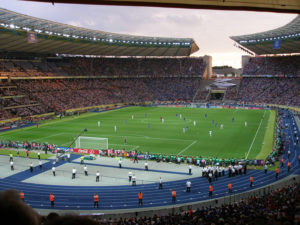
The value of the World Cup has no measure. Once every four years, the most popular sporting event, period, attracts roughly half the globe’s population to watch in one form or another. Fanatics from Afghanistan to Zimbabwe tune in not only for the unparalleled displays of athleticism, teamwork, and strokes of genius in a truly elegant game, but also for the narratives: such and such superstar is liable to take a bite out of the competition, or the Cinderella story unfolding of a country with a total population less than that of Aurora, Colorado. Bill Gates, co-founder of Microsoft and on again-off again richest man in the world, insists that he follows the sport more out of necessity than from an inherent passion for the game, stating, “As I have traveled around the world to better understand global development and health, I’ve learned that soccer is truly universal. No matter where I go, that’s what kids are playing, that’s what people are talking about.”

Considering that this behemoth strikes likes clockwork quadrennially, and that individual countries-figuratively- war with each other over the opportunity to host the event, it behooves inquiring minds to take a look at its environmental impact and energy footprint. Such inquiries have had an effect, as evidenced by the strict regulations FIFA (the governing body of the World Cup) places on the host countries. In preparation for the 2018 games, Russia has had to ensure that each of the 12 stadiums where matches are held passes certain criteria for energy efficiency and environmental sustainability.
The extent to which a stadium can be eco-friendly depends on many factors. For example, anticipating that the games would attract world-wide tourism and thus translate into a flood of rubles for economy, the Russian government seized the opportunity to give facelifts to its soccer stadiums. Commissioned in 2013, the striking Spartak stadium in Moscow was designed with environmental concerns in mind, and therefore has a much smaller footprint than the Luzhniki stadium, where the final between France and Croatia is set to take place. A historically significant building, there was only so much that architects could do to the Luzhniki without interfering with its bones. Still, the stadium was retrofitted with energy-efficient LED lights, high-quality insulation that helps with cooling and heating, and remodeled restrooms that use up to 60% less water.
Though the Luzhniki can seat a whopping 81 thousand spectators, it’s still far from able to accommodate every pair of eyes that will be watching that day. If the 2014 World Cup in Brazil is any indication, 625 million fans will be on the verge of hysteria on Sunday. Though there has been a marked increase in the use of mobile and computer devices to watch sporting events in recent years, the majority of viewers will turn to their TV sets to enjoy the game. Fortunately, television technology has progressed to such an extent that it has become one of the most energy efficient devices in the home; the United States Federal Trade Commission estimates that a TV can be operated for a meager $0.11 per kilowatt hour. If a television requires approximately 400 watts of electricity per hour, and the game runs for about three hours, it will take 750 billion watts (or 750 gigawatts) of energy to shock the world.
But soccer fans aren’t content to just sit at home in their pajamas to enjoy the game. The sale of soccer jerseys makes a pretty penny for sportswear retailers. Adidas estimates sales of about 8 million units this year, which is impressive considering that several countries whose jerseys are usually big sellers (USA, Italy, Turkey) failed to qualify this time round. Sometimes, however, fashion trumps function. Nigeria, though it failed to make waves in the World Cup, stunned the world with its snazzy kits: reportedly, 3 million preorders were placed on Nike’s website for the vintage throwback.
What does this mean in terms of energy footprint? Swedish scientists were able to track the energy life-cycle of a cotton t-shirt. Though jerseys are made from polyester, one of the greatest energy draws of any apparel, regardless of the fabric, is transportation. Consumer habits are changing, as more people turn to the online marketplace to purchase their clothing, therefore positively impacting the carbon footprint since it cuts out the middle man. This spares a jersey the schlep from the factory to the mall, and from the mall to the consumers home. On the flip side, online shopping effectively reduces the need for shop clerks and related positions. The cost-benefit of saving energy at the expense of reducing local employment opportunities is a judgement call that each consumer must take it upon themselves to make.
Nevertheless, the World Cup as a whole is worthy of appreciation for doing just what its name suggests: bringing the entire world to the table to enjoy a cup of friendly (albeit emotionally charged) competition. If nothing else, it turns the topic of conversation onto new and strange ways of doing things. For example, one of the finalists on Sunday, France meets over 75% of its need for electricity from nuclear power… but that’s a topic for another swrm article!



